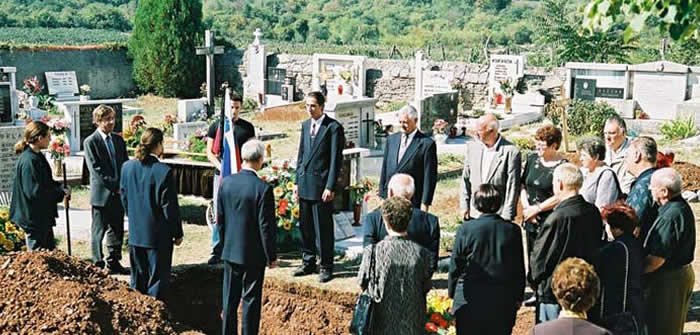 I could never understand the logic of film distributors; avoiding picking up films that are considered “old” by their standards–sometimes even a single year can make a film “old” to them.
I could never understand the logic of film distributors; avoiding picking up films that are considered “old” by their standards–sometimes even a single year can make a film “old” to them.
I have a long list of great films that have lost their chance to be seen by any audiences because of such attitudes. Have we ever stopped watching Chaplin, Hitchcock, Truffaut or Bunuel films because they are old?
Among the wonderful movies of the last four years, we had the Slovenian film entitled Gravehopping, which was directed by Jan Cvitkovic and selected for the Best Foreign Language Film Award at 2007 Oscars, but it never got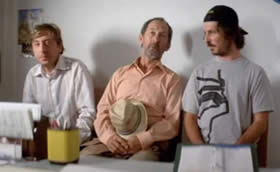 a distribution deal in the U.S.
a distribution deal in the U.S.
Gravehopping won the Cinema Without Borders’ Critics Award at the South East European Film Festival 2007. The film combines tasteful and dark humor with great acting and directing. Without a doubt, Gravehopping is one the top comedies of this decade. Gravehopping tells the story of Pero, an intelligent man in his mid-thirties. He uses his considerable talent as a writer for funeral speeches. These are not mere eulogies for the deceased, since Pero consciously and unconsciously entwines his own perception of past events and his life philosophy into them. He lives in a family house with his sisters Vilma and Ida, his father, and his nephew Johnny. Pero’s neighbor Shooki, Džoni’s father Jagger, and Renata—Pero’s great love—also frequently cross his path.
Here is an interview CWB conducted with Jan Cvitkovia, the director of Gravehopping, a couple years ago.
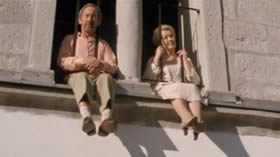 Bijan Tehrani: In Gravehopping you have a poetic and humorous look at death, what inspired you to make this movie?
Bijan Tehrani: In Gravehopping you have a poetic and humorous look at death, what inspired you to make this movie?
Jan Cvitkovic: Usually priests write and perform a funeral speeches, but during the socialist era that was not always the case in area where I live. In every town and every village, some talented persons took over the job. Sometimes it was the retired teacher, the mayor, or just ordinary metal worker or peasant. Situations on funerals were sometimes hilarious and absolutely unreal. That motivated me to try to show that death is actually a very intensive part of life.
Bijan: Your characters while being very unique look quite real. Did you know anyone close to their characters in real life?
Jan: No, I invented the characters and than tried to find the essence of the character in each chosen actor. 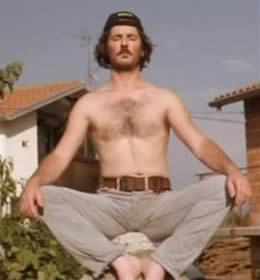
Bijan: Does Semi, (she is IDA!), the mute girl in your film, represent innocence? She has a very special and important presence in the movie, like the presence of Guilietta Masina in La Strada. How did you come up with this character?
Jan: When I write the script, I try not to think, not to involve rational part of my personality too much. The things that come out are more pure that way, more connected with that thing that we call God. I am glad that you felt and understood the role of Ida, the mute girl. She is the pure creature, the connection between Man and God.
Bijan: Has death been a subject you have been dealing a lot with, similar to how Woody Allen is obsessed with the death subject?
Jan: Accepting my own death means understanding the life and the world. There is not many bigger challenges…
Bijan: How challenging was the making of Gravehopping, from raising money to the final stage of production?
 Jan: The money problems I always forget. But making the film was an extremely intense personal trip for me. For example, I was editing this film for one year and three months and during this period I changed my perspective on film and world quite radicaly…
Jan: The money problems I always forget. But making the film was an extremely intense personal trip for me. For example, I was editing this film for one year and three months and during this period I changed my perspective on film and world quite radicaly…
Bijan: Your taste for the casting of your movie is admirable. You look at the actors in the movie and you can’t easily find anybody else playing their part. How did you go about the casting of Gravehopping?
Jan: I just trust my intuition.
Bijan: How do you work with your actors? 
Jan: We developed very special, intense and unique trainings with the actors. It is not based so much on the script or acting techniques, but more on opening of subconscious part of someones personality. I always wait that the last of the actors opens, than we go shooting.
Bijan: Please tell us how you came up with the visual style of Gravehopping? Is this a visual style that you may use for most of your projects?
Jan: I wanted large Cinema Scope shots of nature, shot in golden light. I wanted to catch the special feeling of the planet in the universe. Therefore we also use the sounds of different planets, rings of Saturn, different space atmosphere, recorded by Nasa (they transformed signals from the space to sounds). In interiors I also wanted to have special colors and design – so we studied Edgar Degas’s paintings, because they were the closest to what we wanted to achieve.
Bijan: You write your own stories and direct them, have you ever considered working on someone else material?
Jan: That would have to be really intriguing and challenging script or idea.
Bijan: Please tell us about your future projects.
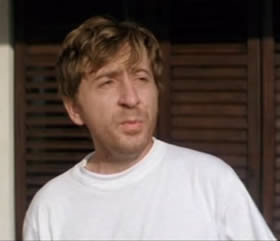 Jan: Film is today for the most part simply a derivate of literature. In other words – authors (of so-termed artistic film as well) most often use motion pictures merely as visual support for various literary types. I myself pushed through this phase and ultimately found that film has more to offer. The product of this realization is the concept for the feature film ARCHEO. I realized already while making my most recent feature film ‘Gravehopping’ that rational thinking actually prevents one from discovering the essence of a film. Building a story in advance, that is writing the screenplay in the classical sense of the term, is actually only the rational production of some sort of construct, which most people tend to need so as to attain a feeling of security. And the need for a sense of security is aroused in response to thousands of years of development; it is practically rooted into the genetic makeup of modern mankind. Its predictable nature ensures various forms of comfort, and in extreme cases even pure delight or catharsis.
Jan: Film is today for the most part simply a derivate of literature. In other words – authors (of so-termed artistic film as well) most often use motion pictures merely as visual support for various literary types. I myself pushed through this phase and ultimately found that film has more to offer. The product of this realization is the concept for the feature film ARCHEO. I realized already while making my most recent feature film ‘Gravehopping’ that rational thinking actually prevents one from discovering the essence of a film. Building a story in advance, that is writing the screenplay in the classical sense of the term, is actually only the rational production of some sort of construct, which most people tend to need so as to attain a feeling of security. And the need for a sense of security is aroused in response to thousands of years of development; it is practically rooted into the genetic makeup of modern mankind. Its predictable nature ensures various forms of comfort, and in extreme cases even pure delight or catharsis.
There is nothing wrong with this of course, only that I myself have grown weary of this and am no longer intrigued by it. What does intrigue me, however, is the destruction of the wall dividing the conscious and unconscious mind. The breakthrough beyond the threshold of consciousness. It is proven that the human subconscious preserves everything it has ever experienced. Some believe (as do I) that the entire experience of everything is preserved in the unconscious mind, and that thus the unconscious is in some manner an expression of the universe. It follows that the subconscious thus represents a potential link to the essence of it all, or with God. And it is precisely this sense of being near to the essence that intrigues me in art. 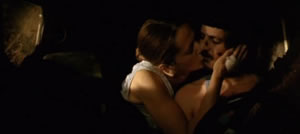
Hence I began to build a film in a different way. It will be composed of seemingly entirely disconnected scenes, which then link together. A Man and a Woman will appear in these scenes, and occasionally also a boy (not theirs). All scenes are based on impressions from my subconscious. Sometimes, under certain conditions (when drowsy, hypnotized, almost in rapture while traveling by airplane, train, etc.), a scene – one of great internal power – appears before my eyes. Sometimes I write it down on a piece of paper, or I enter it into my cell phone, somewhere, anywhere. Sometimes I forget it.
 What all of these scenes have in common is that they are exceptionally elementary. This means that they have been cleansed of all unnecessary rational amusement. The scenes do not exist with any particular underlying reasoning, or moral message or anything of the sort. Rather, they just are. They are as they are and they are beset with an exceptionally potent atmosphere. When I speak of atmosphere, I am actually referring to emotive energy. So, I am waiting for the scenes. And I intend to wait for them all and write them all down all to the very onset of the makings of the film.
What all of these scenes have in common is that they are exceptionally elementary. This means that they have been cleansed of all unnecessary rational amusement. The scenes do not exist with any particular underlying reasoning, or moral message or anything of the sort. Rather, they just are. They are as they are and they are beset with an exceptionally potent atmosphere. When I speak of atmosphere, I am actually referring to emotive energy. So, I am waiting for the scenes. And I intend to wait for them all and write them all down all to the very onset of the makings of the film.
Experience has taught me – including that from my most recent film, which was in part also made this way – the scenes will ultimately tie together into an intelligent whole. Making this film will also set me to trial on my travel to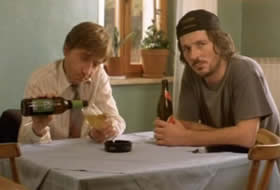 the essence of the medium of film and the termination of traditional attachment of film to literary and other earlier forms and branches of art. A Man, a Woman and a Boy. Three people in a timeless landscape. They don’t know each other, their cultural background is undefined. They try to survive, each on his/her own. Slowly they start to get in some contact which is utterly mistrusting and occasionally hostile, but through various different situations it gradually starts to develop into relationships. We watch each of them in different basic states; the state of fear, happiness, indifference, fury, helplessness, hatred, feeling of being lost and love, in the end. In this way we get to know them and our knowledge about them becomes deeper. The situations in which they appear and meet derive almost exclusively from my subconscious; therefore they are probably archetypal in a sense. But the film is actually about the process of formation of the basic human social and intimate cell. Ur-man, ur-woman and ur-boy slowly get rid of the fear, hostility, and insecurity and join in an ur-community we call family. An ur-film about and ur-family. We intend to shoot this film in autumn. We already have three quarters of the budget and searching for the rest.
the essence of the medium of film and the termination of traditional attachment of film to literary and other earlier forms and branches of art. A Man, a Woman and a Boy. Three people in a timeless landscape. They don’t know each other, their cultural background is undefined. They try to survive, each on his/her own. Slowly they start to get in some contact which is utterly mistrusting and occasionally hostile, but through various different situations it gradually starts to develop into relationships. We watch each of them in different basic states; the state of fear, happiness, indifference, fury, helplessness, hatred, feeling of being lost and love, in the end. In this way we get to know them and our knowledge about them becomes deeper. The situations in which they appear and meet derive almost exclusively from my subconscious; therefore they are probably archetypal in a sense. But the film is actually about the process of formation of the basic human social and intimate cell. Ur-man, ur-woman and ur-boy slowly get rid of the fear, hostility, and insecurity and join in an ur-community we call family. An ur-film about and ur-family. We intend to shoot this film in autumn. We already have three quarters of the budget and searching for the rest.
Bijan: Gravehopping has won the Cinema Without Borders Critics Award at the Southeast European Film Festival. Do you believe that festival awards may help this movie and your future projects?
Jan: Of course, people are sensitive towards the awards. They attract their attention, which is good for the film. Thanks to all the Cinema Without Borders critics.

